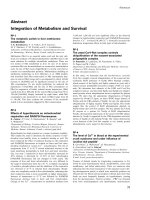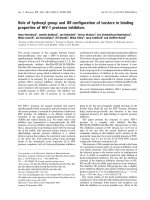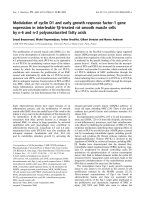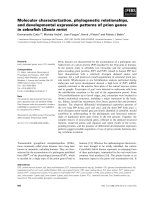báo cáo khoa học: "Nanotechnology in Therapeutics: hydrogels and beyond" doc
Bạn đang xem bản rút gọn của tài liệu. Xem và tải ngay bản đầy đủ của tài liệu tại đây (173.81 KB, 2 trang )
BioMed Central
Page 1 of 2
(page number not for citation purposes)
Journal of Nanobiotechnology
Open Access
Editorial
Nanotechnology in Therapeutics: hydrogels and beyond
OV Salata*
Address: The Wellcome Trust Centre for Human Genetics, Roosevelt Drive, Oxford, OX3 7BN, UK
Email: OV Salata* -
* Corresponding author
Abstract
Nanotechnology in Therapeutics: Current Technology and Applications, Edited by Nicholas A.
Peppas, J. Zach Hilt and J. Brock Thomas (Horizon Bioscience, 2007) contains seventeen chapters
written by leading specialists in the field of polymeric materials for drug delivery and holds wealth
of background as well as state of the art material divided into four sections: "Intelligent
Therapeutics and Responsive Delivery Systems for Improved Absorption and Delivery",
"Therapeutic Micro- and Nanodevices", "Nanostructured Therapeutic Materials" and
"Nanoparticulate Systems in Intelligent Therapy". This newly published volume provides a
stimulating read and a good point of reference to researchers wishing to explore the
interdisciplinary fusion of nnanotechnology and medical therapeutics. The following gives brief
summary and critically reviews the book.
Background
Intelligent therapeutics and responsive delivery systems for
improved absorption and delivery
The very first chapter of this section overviews the "con-
cepts of medical chronobiology, chronopharmacology
and chronotherapeutics" as the basis for applications of
drug delivery technology" and is dealing with the drug
delivery matching to the biological rhythms. Can a doctor
who takes decisions on the drug dosage by monitoring
patient's progress be replaced by an automated system
(see Chapter 2, dedicated to the "Feedback Control in
Drug delivery")? Four diseases are analysed in this context
and only in the simplest single input case of glucose con-
trol in diabetes a feedback control seems to be feasible at
present. One of the major non-technical hurdles in this
field is the acceptance of the technology by both clinicians
and patients.
The advances in drug delivery for nanoparticles are dis-
cussed in the third chapter of this thrilling volume. The
main reason for creating nanoparticles is to improve solu-
bility and bioavailability of drugs. It is a well known phe-
nomenon that nanoparticles can be taken much faster
across the cell membranes. There are also opportunities
here to create a targeted drug delivery. Routes of nanopar-
ticle preparation are described, followed by the discussion
of the requirements to their physical and chemical prop-
erties for effective delivery.
Molecular recognition is one of the central concepts in
biology and is of great importance for the creation of
active synthetic nanomaterials. In the Chapter 4 ("Syn-
thetic Ligand-Receptor Interactions in Delivery Systems")
the authors are describing what is involved in the design
of a synthetic receptor (as opposed to designing a ligand,
which is a more common pharmaceutical problem). The
next chapter is entitled "Nanoscale Analysis of Mucus-
Carrier Interactions for Improved Drug Absorption". It
describes the structure of the mucous layer on the molec-
Published: 26 July 2007
Journal of Nanobiotechnology 2007, 5:5 doi:10.1186/1477-3155-5-5
Received: 26 April 2007
Accepted: 26 July 2007
This article is available from: />© 2007 Salata; licensee BioMed Central Ltd.
This is an Open Access article distributed under the terms of the Creative Commons Attribution License ( />),
which permits unrestricted use, distribution, and reproduction in any medium, provided the original work is properly cited.
Publish with BioMed Central and every
scientist can read your work free of charge
"BioMed Central will be the most significant development for
disseminating the results of biomedical research in our lifetime."
Sir Paul Nurse, Cancer Research UK
Your research papers will be:
available free of charge to the entire biomedical community
peer reviewed and published immediately upon acceptance
cited in PubMed and archived on PubMed Central
yours — you keep the copyright
Submit your manuscript here:
/>BioMedcentral
Journal of Nanobiotechnology 2007, 5:5 />Page 2 of 2
(page number not for citation purposes)
ular level and discusses the interaction of this layer with
synthetic polymers.
The final sixth chapter of the "intelligent therapeutics"
part is dedicated to the polymeric gene delivery vectors.
The use of viral vectors for gene therapy is efficient but
there are obvious safety concerns. The polymeric carriers
are not very efficient at present but can have low cytotox-
icity and immunogenicity. The future gene-polymeric
complexes should be multifunctional and targeted to a
specific disease.
Therapeutic micro- and nanodevices
This section contains three chapters. The first one is enti-
tled "Biohybrid Materials for Therapeutic Devices". Smart
biomaterials incorporating sensing and actuating moie-
ties would allow the therapeutic devices to response to the
changes in the metabolism of an individual. Currently
changes in pH are sensed and result in a mechanical
action (drug release). Hydrogels are a very promising class
of materials for this application. Some exciting examples
are presented. But it is also noted that optimisation, inte-
gration and commercialisation of drug delivery systems
based upon the biohybrid materials is still to be accom-
plished.
The next chapter of the second part is on "Biomimetic Sys-
tems" that are not really defined but illustrated by numer-
ous examples. The final chapter of the second part is
entitled "Nanostructured Scaffolds for Tissue Engineer-
ing". The discussion is focused on scaffolds on a nasnos-
cale level with a primary focus on the polymeric scaffolds.
Extracellular matrix is overviewed first, followed by differ-
ent fabrication and modification techniques used in
nanoscaffolding. Applications examples are also given.
Nanostructured therapeutic materials
It includes chapters on the "Hydrogel Nanocomposites
for Intelligent Therapeutics", "Nanotechnology for Treat-
ing Bone Disorders" and "Nanotechnology and Cancer
Therapy". The hydrogel nanocomposites are classified in
accordance with incorporated nanomaterials. The
mechanical and responsive properties are discussed as
well as potential therapeutic applications. In the chapter
on the bone disorder a good background to the topic is
given. Two major applications of nanotechnology in bone
disorder, nanopatterning of the implant surfaces and drug
delivery to the bone tissue, are discussed. The final chapter
of this part overviews the background knowledge on can-
cer, describes the oral delivery of anti-cancer drugs and
focuses on hydrogels as nanomaterials that can be used in
fighting cancer.
Nanoparticulate systems in intelligent therapy
The final part contains five more chapters, mostly dealing
with various forms of hydrogel materials. The first chapter
is dedicated to dendrimers and star polymers, used for
drug delivery, gene delivery, and chromophore encapsula-
tion. These are very prospective materials but some open
question exists like the biocompatibility of higher genera-
tion dendrimers and their behaviour in the body. Also,
another interesting chapter is describing the shell cross-
linked nanoparticles and their application in drug deliv-
ery.
Verdict
On the whole it is a helpful collection of articles by lead-
ing specialists on some aspects of nanotechnology appli-
cations in medicine. It would be a useful reference book
for a specialist interested to learn about hydrogels and
other polymeric nanocarriers for drug delivery. It will be
also a practical reference and study book for the students
in pharmaceutical and medical fields, who are interested
in the current state of affair of nanomaterials for therapeu-
tics.
Some weak points are the assembly of mainly US authors
and too much emphasis on hydrogels (the lead editor is a
co-author in 7 out of 17 chapters). The division of the
book in to parts and chapter titles are somehow a bit arti-
ficial, although it is clearly covering a lot of new interdis-
ciplinary science, which makes it a difficult task to classify
the material. The final chapter is obviously taken from the
literature review in the doctoral thesis and some editing
efforts should have been made here. But overall it is a use-
ful and timely volume.
References
1. Peppas NA, Hilt JZ, Thomas JB, (ed): Nanotechnology in Thera-
peutics: Current Technology and Applications. Horizon Bio-
science 2007.









